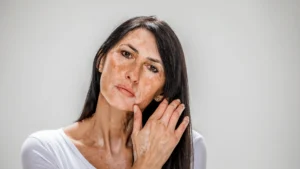Introduction
Vitiligo, a chronic skin condition affecting millions worldwide, is characterized by the presence of white patches on the skin due to the loss of melanocytes. While the exact cause of vitiligo is still debated, it is widely accepted that abnormal immune responses play a crucial role in the development and progression of this condition. Understanding the role of the immune system in vitiligo is essential for finding effective treatments and improving the lives of those affected.

Immune Response
Autoimmunity and T-cells
The immune system’s primary function is to protect the body against harmful pathogens. However, in vitiligo, the immune system mistakenly attacks healthy melanocytes, leading to their destruction. This autoimmune response is believed to involve a subtype of immune cells called T-cells. These T-cells recognize melanocytes as foreign and launch an inflammatory response, causing melanocyte death and the subsequent loss of skin pigmentation. Research also suggests that other immune cells, such as natural killer cells and dendritic cells, may contribute to the immune response in vitiligo.
Oxidative Stress and Autoantibodies
Besides T-cells, oxidative stress and the presence of autoantibodies are believed to play a role in vitiligo. Oxidative stress occurs due to an imbalance between the production of reactive oxygen species and the body’s ability to detoxify them. This stress can trigger the immune system’s reaction against melanocytes. Additionally, autoantibodies, which are antibodies that mistakenly target the body’s own tissues, have been found in the blood of vitiligo patients. These autoantibodies may directly damage melanocytes or contribute to the immune-mediated destruction.
Causes
Genetic and Environmental Factors
The exact causes of vitiligo remain elusive, and it likely arises from a complex interplay of genetic and environmental factors. Studies have identified several genetic variations associated with an increased risk of developing vitiligo, suggesting a genetic predisposition. Additionally, environmental triggers such as sunburn, stress, exposure to certain chemicals, or even viral infections have been linked to the onset or progression of vitiligo. The combination of genetic susceptibility and environmental factors leads to immune dysregulation, initiating the autoimmune response against melanocytes.
Treatment
Topical Medications
Treatment options for vitiligo aim to restore skin color, slow down or stop depigmentation, and prevent the spread of white patches. Topical medications, such as corticosteroids, calcineurin inhibitors, or vitamin D analogs, may be prescribed to reduce skin inflammation and stimulate repigmentation. These medications are commonly applied directly to the affected areas and can help restore some skin color, especially when treatment is initiated early.
Pigment Transplantation
In cases where topical treatments are ineffective, surgical or non-surgical transplantation of melanocytes or melanocyte precursors may be an alternative option. This procedure involves taking healthy melanocytes from unaffected areas and transplanting them onto depigmented skin. While this technique can achieve good results, it is time-consuming and suitable for smaller areas of vitiligo.
Related Conditions
Autoimmune Diseases
Vitiligo has been associated with various other autoimmune diseases, such as thyroid disorders, type 1 diabetes, and rheumatoid arthritis. This connection suggests a shared underlying genetic susceptibility and dysregulation of the immune system.
Psychosocial Impact
Living with vitiligo can have a significant psychological impact on individuals, as the condition alters their appearance. People with vitiligo may experience lowered self-esteem, depression, and anxiety due to societal stigmas and personal perceptions. It is crucial to address the psychological well-being of those with vitiligo alongside medical treatments.
Summary
In summary, the immune system plays a critical role in the development of vitiligo. Autoimmune reactions leading to the destruction of melanocytes are the primary mechanism behind the loss of pigmentation. Genetic factors, environmental triggers, oxidative stress, and autoantibodies contribute to immune dysregulation in vitiligo. Treatment options vary from topical medications to melanocyte transplantation, depending on the extent and response to previous therapies. The association with other autoimmune diseases and the psychosocial impact necessitate comprehensive care for individuals with vitiligo. Continued research is essential to uncover further insights and ultimately find a cure for this challenging condition.